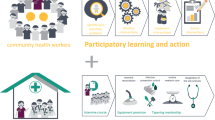Abstract
Purpose Infant mortality reduction in the U.S. has been addressed predominantly through clinical approaches. While these efforts have reduced the infant mortality rate overall, they have not reduced disparities between different racial/socioeconomic groups. To address the interrelated social, economic and environmental factors contributing to infant mortality, a place-based approach is needed to complement existing initiatives and clinical practices. Description Best Babies Zone (BBZ) is an early attempt to put life course theory into practice, taking a place-based approach to reducing infant mortality by aligning resources, building community leadership, and transforming educational opportunities, economic development, and community systems in concentrated neighborhoods. BBZ is currently in three neighborhoods: Price Hill (Cincinnati, OH), Hollygrove (New Orleans, LA), and Castlemont (Oakland, CA). Assessment In its first 4 years, each BBZ crafted resident-driven strategies for decreasing the root causes of toxic stress and poor birth outcomes. To address resident priorities, BBZ sites experimented with tools from other fields (like design thinking and health impact assessment), and emphasized existing MCH strategies like leadership development. Early challenges, including shifting from traditional MCH interventions and addressing health equity, point to areas of growth in implementing this approach in the maternal and child health field. Conclusion BBZ aims to elevate local voice and mobilize multiple sectors in order to address the social determinants of infant mortality, and other initiatives working to improve MCH outcomes can learn from the successes and challenges of the first 4 years of BBZ in order to bring life course theory into practice.
Similar content being viewed by others
References
Alameda County Public Health Department. (2014). East Oakland Innovators. Retrieved from http://www.acphd.org/building-blocks/projects/bbz/east-oakland-innovators.aspx.
Alexander, G. R., & Kotelchuck, M. (2001). Assessing the role and effectiveness of prenatal care: History, challenges and directions for the future. Public Health Reports, 116, 306–316. doi:10.1016/S0033-3549(04)50052-3.
Bell, J., & Rubin, V. (2007). Why place matters: Building a movement for healthy communities. PolicyLink. Retrieved from http://www.policylink.org/sites/default/files/WHYPLACEMATTERS_FINAL.PDF.
Brown, T., & Wyatt, J. (2010). Design thinking for social innovation. Stanford Social Innovation Review, 1–11. Retrieved from http://ssir.org/articles/entry/design_thinking_for_social_innovation.
Bryant, A. S., Worjoloh, A., Caughey, A., & Washington, A. E. (2010). Racial/ethnic disparities in obstetric outcomes and care: Prevalence and determinants. American Journal of Obstetrics and Gynecology, 202(4), 335–343. doi:10.1016/j.ajog.2009.10.864.
Gottlieb, L., Egerter, S., & Braveman, P. (2011). Health impact assessment: A tool for promoting health in all policies. Retrieved from http://www.rwjf.org/en/library/research/2011/05/health-impact-assessment.html.
Harder+Company Community Research. (2015). Best Babies Zone Initiative summary evaluation report, year 3 (2014–15): Building the foundation for success.
Heisler, E. J. (2012). The U.S. Infant Mortality Rate: International Comparisons, Underlying Factors, and Federal Programs. CRS Report for Congress, Congressional Research Service. Retrieved from http://www.fas.org/sgp/crs/misc/R41378.pdf.
Hopkins, E. M., & Ferris, J. M. (Eds). (2015). Place-based initiatives in the context of public policy and markets: Moving to higher ground. Retrieved from https://socialinnovation.usc.edu/files/2014/12/Prioritizing-Place-Moving-to-Higher-Ground.pdf.
Kania, J., & Kramer, M. (2011). Collective impact. Stanford Social Innovation Review, 36–41. Retrieved from http://ssir.org/articles/entry/collective_impact.
Kim, D., & Saada, A. (2013). The social determinants of infant mortality and birth outcomes in western developed nations: A cross-country systematic review. International Journal of Environmental Research and Public Health, 10(6), 2296–2335. doi:10.3390/ijerph10062296.
Loggins, S., & Drumond Andrade, F. C. (2014). Despite an overall decline in U.S. infant mortality rates, the black/white disparity persists: Recent trends and future projections. Journal of Community Health, 39, 118–123.
Lu, M. C., & Halfon, N. (2003). Racial and ethnic disparities in birth outcomes: A life-course perspective. Maternal and Child Health Journal, 7(1), 13–30.
Oswald, B. (2013). Breaking through the clay line [Blog post]. The California Endowment. Retrieved from http://tcenews.calendow.org/blog/breaking-through-the-clay-line.
Pies, C., & Kotelchuck, M. (2014). Bringing the MCH life course perspective to life. Maternal and Child Health Journal, 18, 335–338. doi:10.1007/s10995-013-1408-5.
Serrano, A. (2015). City Council passes resolution against freight trains through Mid-City and Hollygrove. Mid City Messenger. Retrieved from http://midcitymessenger.com/2015/07/24/city-council-passes-resolution-to-oppose-freight-trains-through-mid-city-and-hollygrove/.
Uribe, M., & Luginbuhl, J. (2015). Health and wealth: Building community pathways to economic vibrancy in BBZ Oakland. In: Presentation at the CityMatCH Urban MCH Leadership Conference, Salt Lake City, UT. Abstract retrieved from http://www.citymatch.org/sites/default/files/documents/EFS%202015%20Conference%20Compendium%20Final%20Draft.pdf.
Vechakul, J., Shrimali, B. P., & Sandhu, J. S. (2015). Human-centered design as an approach for place-based innovation in public health: A case study from Oakland, California. Maternal and Child Health Journal, 19(12), 2552–2559. doi:10.1007/s10995-015-1787-x.
Author information
Authors and Affiliations
Consortia
Corresponding author
Rights and permissions
About this article
Cite this article
Pies, C., Barr, M., Strouse, C. et al. Growing a Best Babies Zone: Lessons Learned from the Pilot Phase of a Multi-Sector, Place-Based Initiative to Reduce Infant Mortality. Matern Child Health J 20, 968–973 (2016). https://doi.org/10.1007/s10995-016-1969-1
Published:
Issue Date:
DOI: https://doi.org/10.1007/s10995-016-1969-1




